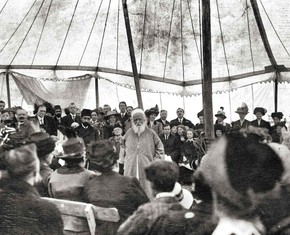The views expressed in our content reflect individual perspectives and do not represent the authoritative views of the Baha'i Faith.
A copious outpouring of divine revelation blessed the nation of Iran in the mid-19th century.
In 1844 in the city of Shiraz, a young merchant declared his mission as the latest in a progression of divine messengers of God. His name was Siyyid Ali Muhammad, and he is known to history as The Bab, meaning “The Gate.”
The Bab’s mission was to proclaim a new Faith and to usher in the revelation of Baha’u’llah, whose title means “the Glory of God.”
During the six short and momentous years of the Bab’s revelation, thousands of individuals recognized his mission and arose to proclaim his new revelation as a healing medicine for the ills which afflicted their institutions and people. Those who accepted his Cause recognized that God’s revelation is not absolute but progressive, based on humanity’s needs and the exigencies of the time.
Many remained indifferent, and some vehemently opposed, oppressed and persecuted the followers of the Bab. He made an enormous claim, saying:
I am, I am, I am, the promised One! I am the One whose name you have for a thousand years invoked, at whose mention you have risen, whose advent you have longed to witness, and the hour of whose Revelation you have prayed God to hasten. – quoted by Nabil in The Dawnbreakers, pp. 315-316.
Truth and reality usually emerge eventually, no matter how long it may take. Again and again, in every era and every corner of the Earth, episodes occur that illustrate, even in the face of tremendous oppression and tyranny, that the spark of reality and the brilliance of truth ultimately become evident. But there are always a few visionary individuals who recognize and articulate reality early on and deeply. Then, decades or even generations later, we witness real social change as an ever-increasing number of people become convinced of the overwhelming evidence of reality that the pioneers see even when it was just a spark.
Those human souls who recognize truth early are often impelled to share this recognition with others, and seek out a cohort of individuals who share a common vision. This leads to friendship, to collaboration, and even to social revolution. Sometimes, these associations are informal conversations and communication, and then sometimes, individuals seeking to expand their community’s appreciation of a truth gather together in more formal settings, like conventions and conferences. Such gatherings bring together people with a common concern or purpose. Participants may or may not fully realize their place in history, and only when we look back do we realize their actions represent a watershed moment in time.

Elizabeth Cady Stanton
In 1848, two women, from opposite parts of the planet and unaware of each other’s existence, attended conferences that were held within weeks of each other. The Babi poetess Tahirih attended the Badasht Conference in the village of Badasht in the province of Khurasan, Iran. Elizabeth Cady Stanton attended the Seneca Falls Convention in a small town in upstate New York. Leading up to these gatherings and following them, both Tahirih and Elizabeth Cady Stanton sacrificed their all, and with zeal and enthusiasm advanced the truth of women’s equality they had embraced. Both women struggled, strived and sacrificed for their vision and for the truth. In so doing, they changed the course of human history.
Eighty-one people attended the Conference of Badasht in July of 1848, which lasted 22 days. Participants were all followers of the Bab, whose declaration in 1844 had set ablaze thousands of souls. Tahirih, one of the earliest Babis and greatly respected by her fellow believers, joined others at the conference. Baha’u’llah, the founder of the Baha’i Faith, who 15 years later in 1863 declared his Faith, directed the proceedings of the conference and served as a host to everyone there.
During the Conference of Badasht, Tahirih appeared in public without a veil.
At that time and in that culture, wearing a veil was considered mandatory for all women—so Tahirih’s revolutionary act shocked many and infuriated some, but Tahirih remained calm and unshaken. She called on her colleagues to break from the traditions of the past and embrace the laws of the Bab’s new revelation.
While only some of her words were recorded for posterity, we know that Tahirih was eloquent, joyful and radiant. Following the conference, she would continue to proclaim the truth of the coming of the new messenger of God, believing it was necessary to abandon the traditions and dogmas that no longer fit the time and must be left behind.
Just a few short years later, Tahirih was brutally martyred for her beliefs. To the end, she spoke of her love and devotion to God and her absolute willingness to die for what she believed in. Her last words were: “You can kill me as soon as you like, but you will never stop the emancipation of women.”
















Comments
Sign in or create an account
Continue with Googleor